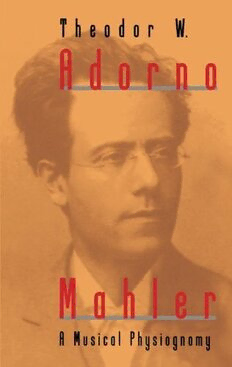
Mahler : a musical physiognomy PDF
Preview Mahler : a musical physiognomy
MAHLER Theodor W, Adorno MAHLER A Musical Physiognomy Translated by Edmund Jephcott THE UNIVERSITY OF CHICAGO PRESS Chicago and London The University of Chicago Press, Chicago 60637 The University of Chicago Press, Ltd., London Q 1992 by the University of Chicago All rights reserved. Published 1992 Paperback edition 1996 Printed in the United States of America 0807 4 S 6 78 910 ISBN 0-226-00769-3 (paperback) First published in Germany as Mahler: Eine mllSikalische Phys;ognomik. CSuhrkamp Verlag, Frankurt am Main, 1971. Library of Congress Cataloging-in-Publication Data Adorno, Thcodor w., 1903-1969. [Mahler, English] Mahler: a musical physiognomy / Thcodor W. Adorno; translated by Edmund Jephcott. p. cm. Translation of: Mahler. Bibliography: p. 1. Mahler, Gustav, 18~1911-<::riticism and interpretation. I. Title. ML41O.M23ASS13 1991 780'.92' +-dc 19 88-14248 CIP MN 8The paper used in this publication meets the minimum requirements of the American National Standard for Infonnation Sciences-Permanence of Paper for Printed Library Materials, ANSI Z39.48-1992. CONTENTS vii Preface to the Second German Edition viii 1 Curtain and Fanfare 2 2 Tone 18 3 Characters 40 4 Novel 60 5 Variant-Form 82 6 Dimensions of Technique 106 7 Decay and Affirmation 122 8 The Long Gaze 144 Notes 168 PREFACE TO THE SECOND GERMAN EDITION ix The text of the second edition is unchanged from the first, except for the correction of misprints. It may be noticed that "Quasi una fantasia," the second volume of the author's musical writings, also contains two texts on Mahler. One is a memorial address given at the invitation of the Gustav Mahler-Gesellschaft in June 1960 in Vienna. It was formulated af ter the completion of the book. This may have given it a certain quality of overview, of detachment from its subject, that justifies its retention alongside the book, which itself aspires to be as close as possible to its subject in the constellation of its individual analyses. It is the book alone that expresses the insight at which the author was aiming. The "Epilegomena" should be read as additional and comple mentary material to the book. Many are concerned with the central complex of the Sixth Symphony. The reader may be reminded again that between this work and "Rewelge" the most profound connec tions exist, going far beyond scattered thematic echoes. The fragment of the Tenth is deliberately not discussed in the book. The philological questions it poses are far too unresolved for the author to permit himself a judgment; without a decision on tex tual problems and an assessment of attempted reconstructions the subject itself could not be validly discussed. All that seems certain to
